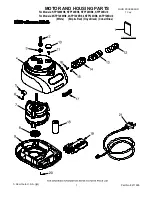
25
Parametric Filter Types and Their Uses
A wide selection of filter types has been made
available under the PEQ section when editing input or
output filters. Scrolling through the various filter types
is achieved by repeated presses of the ENTER key.
Note that this will only change filter types if the filter is
BYPASSED or the GAIN set to 0dB. Bypassing the
filter, then changing types using the ENTER key will
automatically set the gain back to 0dB.
Each filter type will be explained in turn in the
following section.
<- Standard Parametric EQ
InA Input A PEQ:1<>
1k00Hz Q = 3.0 0.0dB
The standard parametric band has adjustable
frequency, 'Q' (or Bandwidth) and Gain controls.
These affect a range of frequencies symmetrically
about the centre freqency as shown in the graph.
Various levels of cut and boost are shown to the
left, along with various 'Q' settings (gain boosts only
are shown below). Remember that 'Q' is 1/Bandwidth,
so the higher the 'Q', the lower the Bandwidth, and
the smaller the range of frequencies affected.
<- Shelving EQ (High Shelf shown)
InA Input A HSF:1-<::
1k00Hz Q = 3.0 0.0dB
Remember – to change filter types, press BYPASS
to bypass the filter, and then use ENTER to select the
filter type.
The shelving EQ has adjustable frequency, 'Q' (or
Bandwidth) and Gain controls. These affect a range of
frequencies from the turnover freqency as shown in
the graph. For a high shelf, frequencies above the
turnover frequency will be affected. For a low shelf,
frequencies below the turnover frequency will be
affected.
Remember that 'Q' is 1/Bandwidth, so the higher
the 'Q', the lower the Bandwidth, and the smaller the
range of frequencies affected.
<- Creating a Flat-topped EQ Response
To create a flat-topped EQ filter response such as
that shown to the left, use two EQ bands, BOTH
configured as low shelves. For an overall BOOST, set
the Lower frequency filter to BOOST the desired
amount, and the Upper frequency filter to CUT by the
same amount.
This example shows one filter at 100Hz and the
other at 2kHz, with the 100Hz filter at –10dB, and the
2kHz filter at +10dB. Varying the 'Q' affects the slope
of the response – values above 0.75 will cause
overshoot as shown.
Assymetrical responses may be achieved by
adjusting the 'Q' of each filter independently.
Manual de Usuario
DSP-2040
Summary of Contents for 11105040
Page 6: ...DSP 2040 User s Manual ...




































